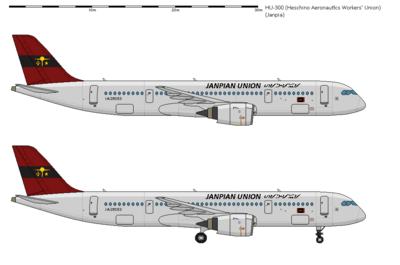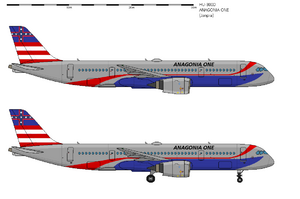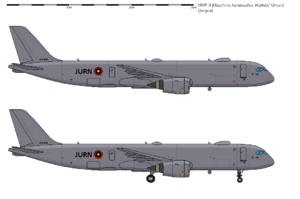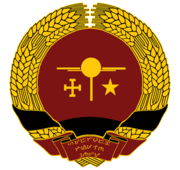Helschino HU-300
| HU-300 | |
|---|---|

| |
| HU-300 serving under the Janpian Airlines | |
| Role | Narrow-body jet airliner |
| National origin | Janpia |
| Manufacturer | Helschino Aeronautics Workers' Union |
| Design group | Helschino Civil Design Department |
| First flight | August 19, 2016 |
| Introduction | February 6, 2017 with the Janpian Airlines |
| Status | In service |
| Primary user | Janpian Airlines |
| Number built | 4,000 or so |
| Variants | |
The HU-300 is a Janpian narrow-body aircraft designed and developed by the Helschino Aeronautics Workers' Union. The development of the aircraft begun when the Workers' Council publicly announced its concept on May 6, 2009, with the aircraft taking its first flight on August 19, 2016. Despite its long development, it managed to gain success, with Janpian Airlines procuring over 100 aircraft the following year to replace their legacy turboprop aircraft for domestic travel. This was followed by a few more orders in the following years, marking the start of its dominance on Janpian domestic travel. The aircraft is manufactured in various locations throughout Janpia, with assembly plants located in Honvosch, Ninschubin, and Deliaschin, major engine components manufactured in Dosanmei, and all of it transported via railway to Alegraschta for the final assembly process.
The aircraft is powered by two Twin Annular Premixing Swirler HCEP-300A engines, which can either be ran with dual digital FADEC controls or conventional hydro-mechanical flight control system. With the FADEC, the HU-300 can fly-by-wire given that it runs through electronics, while the conventional method utilizes a command system to control the hydraulic boosters. Both variants are eco-friendly thanks to the engine's lean-burn technology, giving the aircraft the capability to control its nitrogen oxide (NOx) emissions. Depending on the cabin layout, the HU-300 has a maximum capacity of 180 to 214 passengers, in a 29-28 inch seat pitch configuration between one seat to the other seat at its front. Although this can be changed depending on the use of the aircraft or the end-user, making the cabin fully customizable to meet requirements and expectation. As part of the standard, the aircraft has 8 emergency slides, 4 per each side on the door, which can also function as a life boat. It can take in 8x various AKH ULD-style containers, allowing it to fit in refrigerated items and among other special cargo. It has a cruise speed of 844 kph, a fuel burn of 2.43 liters per seat per 100 km, and a fuel capacity of 27,200L or 7,185.48 Gallons. Currently, the Janpian Airlines is the largest operator of the aircraft, with more than 412 aircraft serving in domestic and limited international flights.
Development
Background
The Heschino Aeronautical Engineering Workers' Union is one of the most prominent aircraft designers and manufacturers in Janpia. However, despite their home advantage, the previous decades were not kind to their industries. In 1954, their COIN aircraft design lost the contract to the Marquesan Aéro-F.V "Whistling Death", given that it had superior loiter time and range, which exceeded the Revolutionary Council's requirements. In the year 2000s, they also lost another significant contract to JURAF as the Revolutionary Council deemed the Lauzannean XF-2A to be better in overall performance for their multirole aircraft as compared to the Union's designs. The following year, they lost yet another contract to JURAF as they picked Lauzannean designs for their helicopter, extending the Union's streak of missed contracts. However, despite their designs losing against foreign competitors, the Heschino Aeronautical Workers' Union gained the rights to manufacture and modify the newly bought foreign designs. The Aéro-F.V "Whistling Death" was produced and modified as the HC-53 "Kischi" (Knight); the XF-2A was produced and redesigned as the H-67 "Hisshin" (Judgement); and the MH-2N was produced as the "Beruschka". These productions gave them the experience, insights, and ideas, which ultimately culminated to their HT-21 design, a trainer aircraft which was their first original design accepted into JURAF, albeit in limited service. While there are merits on technology transfers, the missed scale of contract and mass-production, which could have generated labor, experience, as well as future opportunities, has been few.
In the 54th year of the 5th era, a landmark decision was voted on by the Workers' Council of the Heschino Aeronautical Union to design an airliner that would domestically serve Janpia, with its design supposed to be on par with the rest of the countries. Despite trains being a more popular form of domestic transport, the union aims to utilize air travel as an alternative form of domestic travel, which still remains untapped given the lack of any narrow-body aircraft ran by the Janpian Airlines. Initially, the aircraft was envisioned by Marshal Juneschen to stop Janpia from relying on foreign aircraft designs and to spark the domestic aerospace industry, which has been manufacturing foreign licensed designs for more than a decade. With the economic rise attributed from the 2nd Miracle of the Munschen River, the Helschino Aeronautics Workers' Union got more resources and funding from the Ministry of Industries, which was poured on the union's production lines as well as the aircraft's research and development.
Launch
The first flight of the aircraft was done by a prototype on August 19, 2019, to assess the aircraft design's capabilities, test its limits, and clock its flight time up to the required 1,500 hours. During that period, the Janpian Airlines has made a reservation order of 100 aircraft, meant to replace their legacy turboprop aircrafts that ply along their major domestic routes.
Since its first flight, the aircraft has undergone extensive safety tests and flight experiments for a whole year, in order to fulfill the requirements set by the Aviation Authority of the Ministry of Industry, which resulted in its approval for mass-production and use to the public. On June 6, 2017, with the presence of Marshal Juneschen, the first assembly-made aircraft rolled out of the Helschino factory which was meant to be delivered to the Janpian Airlines. Its delivery journey started at the nearby Dosanmei Airport, and travelled up to 500 kilometers to Kalingrad International Airport, where it soon began its service under a Janpian Airline charter from Kalingrad to Marischa. The aircraft made its first international appearance at a Meridonian Air Show on ??? of ???, with around 12 aircrafts owned by the Janpian Airlines being flown in formation.
Production
As for the assembly procedures, the HU-300 utilize a flush-riveting technique, by having a lower clamp press the material to be riveted up against the rivet head. To solve the problems of dimpling, in which the panels deformed due to uneven interference during the riveting process, the rivet has its own upper pressure foot that is extended, in which it is driven up and down by four compact automation custom cylinders. This enables the two panel, no matter how thin it is, to be rivetted by an 8.7mm thin rivet stacks (depending on panel thickness) without causing dimpling, giving the aircraft with no deformities and enabling it to be aerodynamic. Regardless, these rivets are also checked if its equal to the panel structure and not lower than it, in order to lessen fuselage vibration, shear, and dampen imperfections on the structural integrity, giving the aircraft a smooth and comfortable. As for the fabrication of the aircraft's elementary pieces and components, a water jet cutter is used to cut through sensitive materials such as aluminum or titanium steel, which is a material commonly used for the fuselage of the aircraft. With the cutter, the fabrication of materials are done with exceptional precision, with a plausible error of just 0.51mm, or 0.18mm for non-abrasive cuts. In this manner, there will be no heat-affected zone, which removes any tempering process or changing intrinsic properties of the steel. In particular, this is commonly used for the fabrication of the engine alloys and composites, specifically the titanium fan frame shroud. Regardless, the the water jet fabrication process also has an additional computerized machining to perfect the cutting and make its composition exact in order to reduce further vibrations and potential error, while also taking stress growth into account. Once all these are assembled, the engine in particular would also be tested in a wind tunnel in various power configurations at different wind conditions or weather such as icing or high wind pressures, to evaluate and check its safety all with the use of non-obstructing methods such as X-rays or ultrasound. These tested engines, with approval from the test and evaluation, are then meticulously joint with the HU-300's body including the electronics and fuel lines, and are again tested to see if it functions.
Design
Control
the HU-300 can either use a dual Full Authority Digital Engine Control (FADEC) system, or an optional conventional hydro-mechanical flight control system. Either way, the conventional hydro-mechanical system uses the inputs from the command system to control the aircraft with the use of hydraulic boosters connected to the control areas. The design for it is traditional, with the system using a mechanical circuit connected to a constant speed drive which links the cockpit controls to the hydraulic circuits, which have hydraulic pumps, reservoirs, filters, pipes, valves, and actuators, powered by an electro-hydraulic servo valves. As for the Full Authority Digital Engine Control (FADEC) system, the HU-300 has two of them, with one reserved for emergency and redundancy purposes. Regardless, each FADEC system contains two channels, one for each pilot, with the system being capable of balancing out the control commands from the two pilots, which could be overridden by the captain of the aircraft. Among the advantages of FADEC is that it allows the pilots to control the aircraft automatically, which reduces the need for heavy mechanical parts. Given that it runs through electronics, the aircraft also has a fly-by-wire program that controls the engines and actuators, allowing the aircraft to adjust without requiring manual interference from the pilot itself. This can be done with the use of an integrated drive generator, which uses differential action to generate electrical energy from the kinetic energy of the aircraft via the engine turbine. Furthermore, given that the system is digital, the aircraft can automatically run self-diagnostic checks throughout the mechanical parts such as its engines, and allowing the aircraft to autonomously fly, which also reduces the pilot's duties to just watching other flight instruments. Among the programs of the FADEC are its automated thrust control system, which conserves and maximizes fuel use efficiency by metering its amount required to attain a certain speed or the assigned power during the different stages of flight. It also has a ground collision-avoidance system, which was developed from the Union's experience when creating programs for the H-98 Hisshin Aircraft.
Automated Landing System
As part of the standard safety system, the FADEC is also equipped with an Airborne Collision Avoidance System (ACAS), which gives the pilots full situational awareness on air traffic and also providing them with an AIS transponder. Furthermore, it can also automatically land along the runway with zero visibility thanks to its auto landing system, which works by utilizing the instrument landing system taken from ground radars or airports. This system is rated CAT IIIC, as it is capable of measuring the crosswinds, distance, as well as the height with the use of radio altimeter, which all determines the decision height to automatically align it to the runway centerfold during the landing process; all without the need for runway visual range (RVR). Once the aircraft has landed, the autopilot or landing mode can be disconnected to allow the pilots to brake the aircraft by utilizing the reverse thrust.
Engines
Powering this aircraft are two HCEP300A turbofan engines, which can reach a maximum thrust of 24,008.64 lbf, with a bypass ratio of 11:1. As for the engine arrangement, the HCEP300A is in a dual rotor, axial flow configuration, with over 9 stages of high pressure compressor, 3 stages of low pressure compressor, and 1 geared fan. These compressors, as the name suggests, pressurize the air just enough before it enters the combustor, giving it sufficient power to run it. For its turbine, the HCEP300A has 2-stages of high-pressure turbines and 7-stages of low-pressure turbines. These turbines gather energy by letting hot, high-speed air coming from the combustor, which in turn speeds the turbine and the engine shaft, allowing it to power the aircraft accessory drives that run the fuel control units, lubrication oil pumps, starters, generators, tachometer sensor drives, and alternators. All these turbines utilize a matrix composite shroud, which has high heat resistance and is low-weight for better performance. As for the material for the low-pressure turbines, a titanium fan frame shroud is used, which is a non-magnetic material and a poor conductor of heat and electricity, making it durable and light-weight at the same time.
At the heart of the engine is a single annular combustor that utilizes lean-burn technology in a Twin Annular Premixing Swirler (TAPS) configuration, in which each fuel injector have a concentric outer main, as well as a center pilot in which the tip is similar to the traditional rich-burn configurations. This type of configuration allows the engine to maximize fuel efficiency by having two modes with the fuel split between the center pilot as well as the main in high-power operations, and the center pilot being fully used in low-power operations. In this manner, the engine regulates and minimizes the high gas temperatures to control its nitrogen oxide (NOx) emissions, significantly reducing any health impacts outside the engine, as well as making it eco-friendly, less impactful to the climate environment, and aligning with modern standards. While it still uses traditional rich-burn configurations in high-power operations, this type of mode only peaks at landing or takeoff operations, in which the aircraft requires more power to generate thrust, thus the use of traditional rich-burn configurations.
Reverse Thrust
The HCEP300A uses a one-piece O-duct sliding aft, which is better than traditional fan-ducts since the design reduces drag in the engine’s secondary flow-path. This enhances the airflow and improves fuel consumption for the engine. It also reduces engine surface wear by maintaining a streamlined shape, all while letting air exit past the bullnose seal. This duct is controlled by an Electrical Thrust Reverser Actuation System (ETRAS) for full efficiency, topped with a Thrust Reverser Control Unit (TRCU) from the Dual Full Authority Digital Engine Control (FADEC). This system drives the O-ducts without needing much heavier hydraulics, all while concentrating the power supply to the actuator. In terms of maintenance, the ETRAS system would still be required given the weight of the two engine sections would be too heavy to be manually lifted. These two sections are the fan ducts and the thrust reversers, which must rotate upward around the huge hinge pins for access. Regardless, two bifurcation beams are needed with one for the upper and the lower section connects the whole section.
Variants
TBA
Operators
 Janpia - The Janpian Airlines operates over 412 HU-300 aircrafts and 25 HU-300D
Janpia - The Janpian Airlines operates over 412 HU-300 aircrafts and 25 HU-300D
- JURN operates a few amount of HMP-3 Maritime Patrol Aircraft, which is a variation of the HU-300
![]() Anagonia - Operates over 23 HU-300D Aircrafts.
Anagonia - Operates over 23 HU-300D Aircrafts.
Specifications
| General Characteristics | |
|---|---|
| Nomenclature | HU-300 (Helschino Aeronautics Workers' Union - 300 Series) |
| Nation-of-origin | Janpian Union of Revolutionary States |
| Designer | Helschino Civil Design Department |
| Manufacturer | Helschino Aeronautics Workers' Union |
| Engine | |
| Turbofan | HCEP300A |
| Maximum Thrust | 23,511.58 lbf / 104.58 kN |
| Take-off Thrust | 24,008.64 lbf / 106.79 kN |
| Fuel Burn | 2.43 liters per seat per 100 km |
| Thrust/Flat-rated Temperature | 28,400 / 86F |
| Compressor | 9-stage HPC, 3-stage LPC, 1 geared fan, in axial configuration |
| Turbine | 2-stage high pressure turbine, 7-stage low pressure turbine, in dual rotor, axial flow configuration |
| Turbine Material | Titanium Fan Frame Shroud |
| Combustor | Single Annular Combustion (SAC) with Twin Annular Premixing Swirler (TAPS) |
| Bypass Ratio | 11:1 |
| Thrust-to-Weight Ratio | 0.138 in MTOW |
| Thrust Reverse | Electrical Thrust Reverser Actuation System (ETRAS) with digital Thrust Reverser Control Unit (TRCU) |
| Control | Dual Full Authority Digital Engine Control (FADEC) |
| Maximum Fuel Pressure | 3800 hPa |
| Minimum Fuel Pressure | 345 hPa |
| Dimensions | |
| Fuselage Length | 42.3 meters |
| Fuselage Width | 4.1 meters |
| Cabin Length | 30.1 meters |
| Cabin Width | 3.8 meters |
| Wingspan | 35.9 meters |
| Tail Height | 11.9 meters |
| Wheelbase | 14.1 meters |
| Engine Ground Clearance | 70 cm |
| Capacity | |
| Max Passenger Capacity | 180-214 @ 29-28 |
| Cargo Door | 82 inch width x 43 inch height |
| Cargo Capacity | 8x AKH ULD |
| Fuel Capacity | 27,200L / 48,142.72 lbs / 7,185.48 Gallons / 21,837.17 kg |
| Weight | |
| Maximum Ramp and Takeoff Weight | 85.1 Tons |
| Maximum Landing Weight | 67.2 Tons |
| Operating Empty Weight | 43.8 Tons |
| Performance | |
| Minimum Runway Takeoff (MTOW) | 2,045 meters |
| Minimum Runway Landing | 1,515 meters |
| Ceiling | 40,000 feet |
| Approach Speed | 137 KIAS |
| Cruise Speed | 844 kph / Mach 0.68 |
| Maximum Speed | 979 kph / Mach 0.793 |
| Range | 3,065.87 nmi / 5,678 km |




